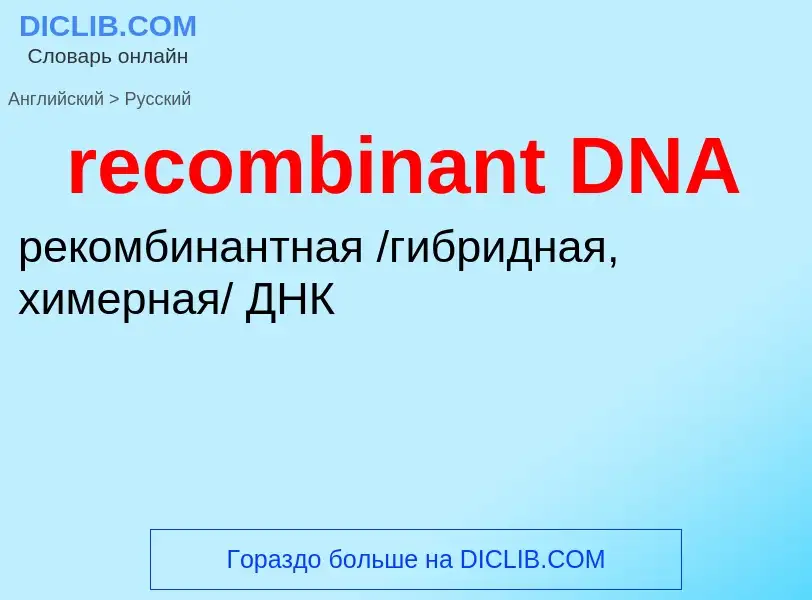Перевод и анализ слов искусственным интеллектом ChatGPT
На этой странице Вы можете получить подробный анализ слова или словосочетания, произведенный с помощью лучшей на сегодняшний день технологии искусственного интеллекта:
- как употребляется слово
- частота употребления
- используется оно чаще в устной или письменной речи
- варианты перевода слова
- примеры употребления (несколько фраз с переводом)
- этимология
recombinant DNA - перевод на русский
общая лексика
рекомбинантная ДНК
общая лексика
химерный [рекомбинантный] белок
медицина
рекомбинационный белок
общая лексика
генная [генетическая] инженерия
метод рекомбинантных ДНК
общая лексика
ДНК
дезоксирибонуклеиновая кислота
(Distributed Internet Application) распределённые приложения Интернет, архитектура DNA
(Digital Network Architecture) архитектура цифровой сети
сетевая архитектура, разработанная корпорацией Digital Equipment. Реализована в сети DECnet
синоним
Смотрите также
существительное
общая лексика
архитектура цифровых сетей
синоним
['s(j)u:pəkɔil]
общая лексика
суперспираль
спираль второго порядка
синоним
['s(j)u:pəkɔild]
биохимия
сверхспиральный (об укладке молекулы ДНК)
прилагательное
биохимия
сверхспиральный (об укладке молекулы ДНК)
общая лексика
сверхспиральная ДНК
синоним
общая лексика
дезоксирибонуклеиновая кислота
ДНК
химия
кислота дезоксирибонуклеиновая
медицина
ДНК (дезоксирибонуклеиновая кислота)
общая лексика
двунитевая [двухцепочечная] ДНК
Википедия
Recombinant DNA (rDNA) molecules are DNA molecules formed by laboratory methods of genetic recombination (such as molecular cloning) that bring together genetic material from multiple sources, creating sequences that would not otherwise be found in the genome.
Recombinant DNA is the general name for a piece of DNA that has been created by combining two or more fragments from different sources. Recombinant DNA is possible because DNA molecules from all organisms share the same chemical structure, differing only in the nucleotide sequence. Recombinant DNA molecules are sometimes called chimeric DNA because they can be made of material from two different species like the mythical chimera. rDNA technology uses palindromic sequences and leads to the production of sticky and blunt ends.
The DNA sequences used in the construction of recombinant DNA molecules can originate from any species. For example, plant DNA can be joined to bacterial DNA, or human DNA can be joined with fungal DNA. In addition, DNA sequences that do not occur anywhere in nature can be created by the chemical synthesis of DNA and incorporated into recombinant DNA molecules. Using recombinant DNA technology and synthetic DNA, any DNA sequence can be created and introduced into living organisms.
Proteins that can result from the expression of recombinant DNA within living cells are termed recombinant proteins. When recombinant DNA encoding a protein is introduced into a host organism, the recombinant protein is not necessarily produced. Expression of foreign proteins requires the use of specialized expression vectors and often necessitates significant restructuring by foreign coding sequences.
Recombinant DNA differs from genetic recombination in that the former results from artificial methods while the latter is a normal biological process that results in the remixing of existing DNA sequences in essentially all organisms.



![DNA major and minor grooves. The latter is a binding site for the [[Hoechst stain]] dye 33258. DNA major and minor grooves. The latter is a binding site for the [[Hoechst stain]] dye 33258.](https://commons.wikimedia.org/wiki/Special:FilePath/DNA-ligand-by-Abalone.png?width=200)
![animated version]]). animated version]]).](https://commons.wikimedia.org/wiki/Special:FilePath/DNA animation.gif?width=200)

![B]] and [[Z-DNA]] B]] and [[Z-DNA]]](https://commons.wikimedia.org/wiki/Special:FilePath/Dnaconformations.png?width=200)

.jpg?width=200)




![[[Maclyn McCarty]] (left) shakes hands with [[Francis Crick]] and [[James Watson]], co-originators of the double-helix model based on the X-ray diffraction data and insights of Rosalind Franklin and Raymond Gosling. [[Maclyn McCarty]] (left) shakes hands with [[Francis Crick]] and [[James Watson]], co-originators of the double-helix model based on the X-ray diffraction data and insights of Rosalind Franklin and Raymond Gosling.](https://commons.wikimedia.org/wiki/Special:FilePath/Maclyn McCarty with Francis Crick and James D Watson - 10.1371 journal.pbio.0030341.g001-O.jpg?width=200)
![Interaction of DNA (in orange) with [[histone]]s (in blue). These proteins' basic amino acids bind to the acidic phosphate groups on DNA. Interaction of DNA (in orange) with [[histone]]s (in blue). These proteins' basic amino acids bind to the acidic phosphate groups on DNA.](https://commons.wikimedia.org/wiki/Special:FilePath/Nucleosome1.png?width=200)




![The Eagle]] [[pub]] commemorating Crick and Watson The Eagle]] [[pub]] commemorating Crick and Watson](https://commons.wikimedia.org/wiki/Special:FilePath/TheEaglePub-Cambridge-BluePlaque.jpg?width=200)





